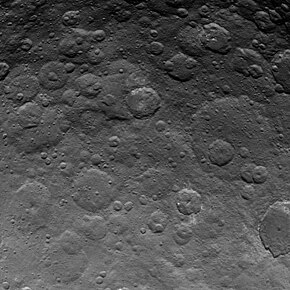


Coniraya (center right, overlain by three smaller craters). Gaue is at lower right, cut-off by the edge of the image.
| |
| Feature type | Impact crater |
|---|---|
| Location | Coniraya Quadrangle, Ceres |
| Coordinates | 39°52′N 65°31′E / 39.86°N 65.51°E / 39.86; 65.51[1] |
| Diameter | ~135 kilometres (84 mi)[1] |
| Depth | ~500 m[2] |
| Discoverer | Dawn |
| Eponym | Coniraya Viracocha, Incan lunar deity |
Coniraya is a large, shallow crater on the dwarf planet Ceres. It is the namesake for the Coniraya Quadrangle.[3]
The crater is named after the Incan lunar and fertility deity, Coniraya Viracocha (Kon Iraya Wiraqocha), who came to earth at Huarochirí (Waruchiri), and created villages, terraced fields and irrigation canals. The name was officially approved by the International Astronomical Union (IAU) on 3 July 2015.[1]
Coniraya is an unusually shallow crater; despite having a diameter of roughly 135 kilometers, it is only 500 meters deep. This is in contrast to the neighboring crater Vinotonus, which is similar in size and age yet ten times deeper. The shallow depth of Coniraya may have been caused by viscous relaxation, though only if Ceres's crust at the impact site was unusually enriched in water ice. The impact which created Coniraya was caused by a large body travelling an unusually low speed.[2] Coniraya is estimated to be approximately 1.3 billion years old despite its degraded state.[3]
|
| ||||||||
|---|---|---|---|---|---|---|---|---|
| ||||||||
| Geography (Features) |
| |||||||
| Astronomy |
| |||||||
| Exploration |
| |||||||
| Related |
| |||||||
This article about an extraterrestrial geological feature is a stub. You can help Wikipedia by expanding it. |